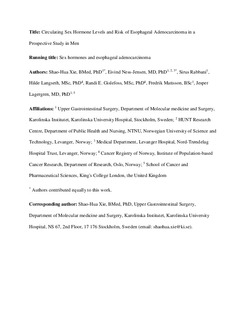| dc.description.abstract | OBJECTIVES: Sex hormones have been hypothesized to explain the strong male predominance in esophageal adenocarcinoma, but evidence is needed. This study examined how circulating sex hormone levels influence future risk of esophageal adenocarcinoma. METHODS: This case-control study was nested in a prospective Norwegian cohort (Janus Serum Bank Cohort), including 244 male patients with esophageal adenocarcinoma and 244 male age-matched control participants. Associations between prediagnostic circulating levels of 12 sex hormones and risk of esophageal adenocarcinoma were assessed using conditional logistic regression. In addition, a random-effect meta-analysis combined these data with a similar prospective study for 5 sex hormones. RESULTS: Decreased odds ratios (ORs) of esophageal adenocarcinoma were found comparing the highest with lowest quartiles of testosterone (OR = 0.44, 95% confidence interval [CI] 0.22–0.88), testosterone:estradiol ratio (OR = 0.37, 95% CI 0.19–0.72), and luteinizing hormone (OR = 0.50, 95% CI 0.30–0.98), after adjustment for tobacco smoking and physical activity. These associations were attenuated after further adjustment for body mass index (OR = 0.56, 95% CI 0.27–1.13 for testosterone; OR = 0.46, 95% CI 0.23–0.91 for testosterone:estradiol ratio; OR = 0.55, 95% CI 0.29–1.08 for luteinizing hormone). No associations were observed for sex hormone–binding globulin, dehydroepiandrosterone sulfate, follicle-stimulating hormone, prolactin, 17-OH progesterone, progesterone, androstenedione, or free testosterone index. The meta-analysis showed an inverse association between testosterone levels and risk of esophageal adenocarcinoma (pooled OR for the highest vs lowest quartile = 0.60, 95% CI 0.38–0.97), whereas no associations were identified for androstenedione, sex hormone–binding globulin, estradiol, or testosterone:estradiol ratio. DISCUSSION:
Higher circulating testosterone levels may decrease the risk of esophageal adenocarcinoma in men. | nb_NO |
